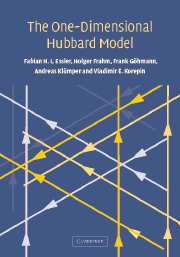Book contents
- Frontmatter
- Contents
- Preface
- 1 Introduction
- 2 The Hubbard Hamiltonian and its symmetries
- 3 The Bethe ansatz solution
- 4 String hypothesis
- 5 Thermodynamics in the Yang-Yang approach
- 6 Ground state properties in the thermodynamic limit
- 7 Excited states at zero temperature
- 8 Finite size corrections at zero temperature
- 9 Asymptotics of correlation functions
- 10 Scaling and continuum limits at half-filling
- 11 Universal correlations at low density
- 12 The algebraic approach to the Hubbard model
- 13 The path integral approach to thermodynamics
- 14 The Yangian symmetry of the Hubbard model
- 15 S-matrix and Yangian symmetry in the infinite interval limit
- 16 Hubbard model in the attractive case
- 17 Mathematical appendices
- References
- Index
14 - The Yangian symmetry of the Hubbard model
Published online by Cambridge University Press: 19 August 2009
- Frontmatter
- Contents
- Preface
- 1 Introduction
- 2 The Hubbard Hamiltonian and its symmetries
- 3 The Bethe ansatz solution
- 4 String hypothesis
- 5 Thermodynamics in the Yang-Yang approach
- 6 Ground state properties in the thermodynamic limit
- 7 Excited states at zero temperature
- 8 Finite size corrections at zero temperature
- 9 Asymptotics of correlation functions
- 10 Scaling and continuum limits at half-filling
- 11 Universal correlations at low density
- 12 The algebraic approach to the Hubbard model
- 13 The path integral approach to thermodynamics
- 14 The Yangian symmetry of the Hubbard model
- 15 S-matrix and Yangian symmetry in the infinite interval limit
- 16 Hubbard model in the attractive case
- 17 Mathematical appendices
- References
- Index
Summary
In this chapter we will reveal another piece of the algebraic structure of the Hubbard model. As was first observed by Uglov and Korepin [462], the Hubbard Hamiltonian on the infinite line is invariant under the action of the direct sum of two so-called Yangian quantum groups, extending the rotational and the η-pairing su(2) symmetries we encountered earlier. Following [172] we shall address the issue in a more general context. We present two pairs of fermionic representations of the Y(su(2)) Yangian quantum group which commute with the trigonometric [162] and hyperbolic [40, 41] versions of a Hubbard Hamiltonian with non-nearest-neighbour hopping. In both cases the two representations are also mutually commuting, hence can be combined into a representation of Y(su(2))⊕Y(su(2)). The generators of the Yangian symmetry of the ordinary Hubbard model (with nearest-neighbour hopping) and of a number of other interesting models like the Haldane-Shastry spin-chain [194, 394] are obtained as special cases of our general result.
Introduction
Quantum groups were introduced by Drinfeld [107, 109]. His original intention was to put what we called the Yang-Baxter algebra into the mathematically more conventional context of Hopf algebras. The Yangians are special quantum groups. Their representation theory [80, 81] is intimately related to the classification of integrable quantum systems with rational R-matrices.
- Type
- Chapter
- Information
- The One-Dimensional Hubbard Model , pp. 563 - 598Publisher: Cambridge University PressPrint publication year: 2005



